Trade show presence showcases Aussie wool

AWI’s subsidiary The Woolmark Company exhibits at the world’s most important international textile trade shows to inspire the world’s leading manufacturers, brands and retailers to include wool in their upcoming collections.
With the global emergency caused by the COVID pandemic now ended, face-to-face trade shows have almost fully resumed. They are once again providing opportunities for The Woolmark Company to continue and develop business-to-business relationships with the world’s leading textile and apparel companies.
The shows are like a mecca for leading product developers, brand buying and sourcing teams, designers, manufacturers and retailers from across the world.
“Attending international trade shows is vital for The Woolmark Company to effectively showcase and promote the natural and performance benefits of Australian wool, our new product and process developments as well as The Wool Lab sourcing guide (see overleaf),” explained AWI General Manager, Processing Innovation & Education Extension, Julie Davies.
“Our presence provides an important source of leads for business development as well as the opportunity to support our trade partners. It enables in-depth discussions with key manufacturing partners and those within the textile supply chain, to bring wool to the forefront of their minds for inclusion in their future collections and product ranges.
“Ultimately, our activities at trade shows aim to grow profitable demand for wool for the benefit of Australian woolgrowers.”
The Woolmark Company’s product innovations on display at recent trade shows have included the latest brand collaborations with the Luna Rossa Prada Pirelli sailing team, Nissan’s Formula E motor racing team and Volvo Cars, Shima Seiki Italia on snow sports apparel through to the award-winning designs from The Woolmark Company’s pioneering International Woolmark Prize and Woolmark Performance Challenge.
“With a global interest in sustainability and natural fibres, it really is a great moment for wool. Wool’s versatility and strong eco-credentials continue to attract opportunities for fashion and performance apparel as well as new applications including footwear, interiors (plus automotive interiors) and accessories,” Julie said.

Trade shows are a unique opportunity for The Woolmark Company to connect with key supply chain partners.
Window of opportunity
June to October is a crucial time in the yearly fashion cycle. It is during this time that retailers and brands in the northern hemisphere collect product ideas for their following year’s autumn/winter collections. It takes at least 12 months for the trade to design and order garments, manufacture and transport them, and then stock them in the shops.
“The Woolmark Company has a ‘window of opportunity’ each year to convince brands and retailers to stock wool for a particular season – it’s important to get the timing right. For example, there would be no point in us doing our trade marketing a month after they had already made their buying decisions,” Julie explained.

Trade shows enable promotion of The Wool Lab sourcing guide and showcase the latest innovative wool developments. PHOTOS: Matteo Mastrogiuseppe
For the northern hemisphere’s 2024/25 autumn/winter season collections, The Woolmark Company is exhibiting at large and influential trade shows including:
- ITMA textile and garment technology show, Milan (June)
- Pitti Filati yarn and knitwear show, Florence (June)
- Première Vision fabric and apparel show, Paris (July)
- Milano Unica fabric and yarn show, Milan (July)
- Preview in Seoul apparel fabric show, Seoul (August)
- Performance Days sports and performance show, Munich (October)
- Japan Creation apparel fabric show, Tokyo (October)
In the weeks following trade shows, ongoing engagement and education are held by The Woolmark Company’s global offices individually with retailers and brands. Training of retail decision makers, such as the company’s buyers, merchandisers, designers and technologists, is undertaken to both stimulate interest and build their confidence to invest in wool product lines.
“Education and training of supply chain participants ensures wool remains competitive against other fibres and inspires designers, brands and retailers to use wool in their product ranges,” Julie added.
This article appeared in the September 2023 edition of AWI’s Beyond the Bale magazine. Reproduction of the article is encouraged.












